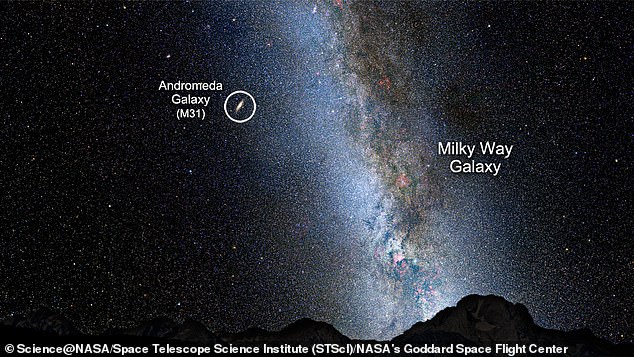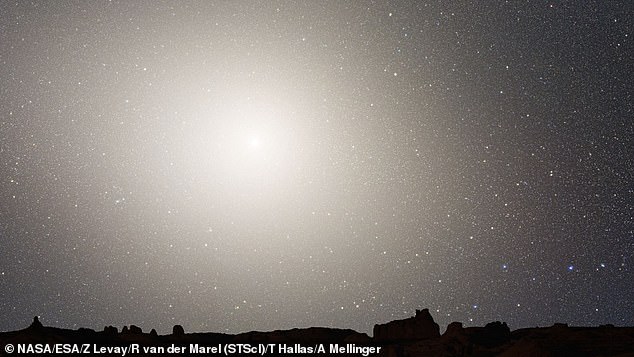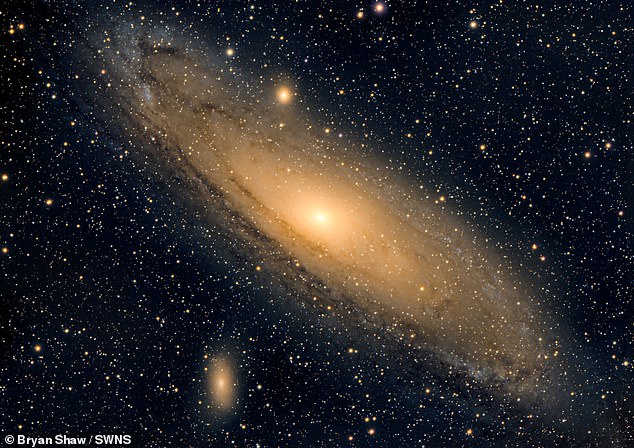The end of the world may not be something we enjoy thinking about, but a new study has provided a terrifying glimpse of what could be coming.
Astronomers say there is a 50 percent chance that the Andromeda galaxy, also known as Messier 31, will collide with the Milky Way within the next 10 billion years, swallowing Earth in the process.
While this may seem like bad news, a 50/50 chance is actually less certain than scientists previously assumed.
If the collision were to occur, the planets and stars of the two galaxies would be thrown together, creating a supergalaxy known as “Milkdromeda.”
There is a small chance that our Sun could collide with another star, which could alter our position relative to the Sun and threaten life on Earth, if it still exists by then.
This illustration shows one stage of the projected merger between our galaxy, the Milky Way, and the neighboring Andromeda galaxy, as it will unfold over the next few billion years. In this image, which depicts Earth’s night sky 3.75 billion years from now, Andromeda (left) fills the field of view and begins to distort the Milky Way with tidal pull.
The new study is authored by an international group of astronomers, including Professors Alis Deason and Carlos S. Frenk of Durham University.
“Our own Milky Way is commonly believed to be on a collision course with its neighboring galaxy… predicted to occur in about five billion years,” they say in their paper.
“But there is no certainty of a collision between the Milky Way and Andromeda.”
At 2.5 million light-years away, Andromeda is the closest large galaxy to our Milky Way galaxy.
Astronomers have long known that Andromeda and the Milky Way are being pulled toward each other by the forces of gravity.
They are expected to merge in about 4.5 billion years and form a giant “elliptical galaxy” shaped like an elongated circle, NASA says.
But according to the authors of the new study, the nature of the merger could depend on an overlooked “confounding factor.”
Specifically, there may be a strong gravitational influence from other galaxies in what is known as the “Local Group” that could affect its direction.
The Local Group is a group of more than 30 galaxies to which both the Milky Way and Andromeda belong.
Other galaxies in the “Local Group” include the Large Magellanic Cloud (LMC), the Triangulum Galaxy (M33), Leo I, and NGC 6822.

Current view of Andromeda and the Milky Way. Astronomers have long known that Andromeda and the Milky Way are held together by the forces of gravity.

NASA says that within 7 billion years, the two galaxies will have combined and formed a huge elliptical galaxy (artist’s impression)
Using observations made by the Gaia and Hubble space telescopes, the researchers estimated future scenarios for the evolution of the Local Group over the next 10 billion years.
‘We find that the next most massive galaxies in the Local Group, namely M33 and the Large Magellanic Cloud, clearly and radically affect the orbit of the Milky Way-Andromeda galaxy,’ they report.
‘Uncertainties in the current positions, motions and masses of all galaxies leave room for drastically different results.’
There is a “close to 50 percent” chance that there will be no merger between the Milky Way and Andromeda in the next 10 billion years, they conclude.

The Andromeda Galaxy is approximately 2.5 million light-years from Earth and is the closest large galaxy to our Milky Way galaxy.
If the collision does occur, there is of course the possibility that it will occur after our Sun has run out of hydrogen and died.
In the highly unlikely event that the collision between the Milky Way and Andromeda occurred while we Earthlings were still alive on Earth, we might survive.
According to NASA, the Sun and the planets orbiting it “will survive the collision but will adopt new coordinates in the cosmos.”
Eric Bell, an astronomy professor at the University of Michigan who was not involved in the new study, agreed that “it’s very likely that nothing would happen to us” if the galaxy collided.
As the merger occurs, the Sun will likely be flung into a new region of our galaxy, but Earth and the rest of the solar system will not be in danger of being destroyed.
However, a potential danger of a galaxy merger would be a collision (or near collision) between our star and another star, although there is an extremely small chance of that happening.
“Galaxy collisions would only be dangerous because of a slightly higher probability of collisions between stars,” Professor Bell told MailOnline.
Even a close collision with another star – a “close pass” – would affect our orbit, which Professor Bell says would be “very bad”.
“The close pass changes the orbit, bringing us closer to the Sun or further away,” he said.
‘Our fate depends on how exactly our orbit changes.
‘So we would either escape the solar system (in which case we would slowly freeze to death over months) or be cooked by the sun (which could be very fast or take months, depending on which orbit we ended up in).’
The new study has been published as a preprint in arXiv server, meaning it has not yet been peer-reviewed.


